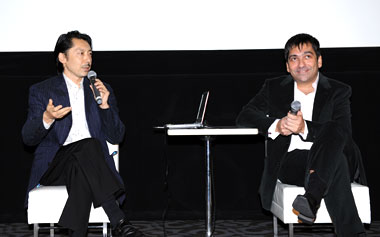2008.10.25
[Updates]
TIFF Earth Conference held on October 24th (Friday)
TIFF Earth Conference is a new project introduced this year at which filmmakers will speak on their experiences and share views with the audience in accordance with the theme of the 21st TIFF – “Ecology”.
What can we do at TIFF as a first step toward becoming more aware of the need to protect the global environment? While screening films from around the world with different messages related to “protection of the Earth”, we have also invited those involved in film-making to discuss various themes, such as nature, their hometowns and the global environment.
Following to the screening, Mr. Sophokles Tasioulis, one of the producers of the film ‘earth’, and Professor Shinichi Takemura, a professor at Kyoto University of Art and Design, spoke in front of the audience.

Professor started off by asking the producer about the production of the film.
Q (Prof. Takemura): How did you come about producing ‘earth’?
A (Tasioulis): After releasing ‘Deep Blue’ in 2004, we thought of what we would do next. We wanted to shoot to show everyone, the great rivers and forests of the world, in ways that no one dared before. In portraying our planet, we wanted to focus on its beauty as well as problems in the way the audience could sympathize.
Q (Prof. Takemura): Please tell us about the camera technique you used.
A (Tasioulis): One of the biggest breakthroughs for us was the aerial cinematography. The aerial system that we invented enabled us to fly with helicopters almost 2 kilometers high up in the air. It was so far away that the only person who could see the animals was the cameraman through his zoom lenses. This way, we could shoot the nature without any disturbance. We also used special techniques and technology to shoot animals in water.”
Q (Prof. Takemura): What would be your next project?
A (Tasioulis): That’s a tough question. Shooting ‘earth’ was like climbing up the Everest. We went limp with relief. But after climbing up the mountain, we first need to climb down. The wonderful music in the film is performed by Berlin Philharmonic Orchestra. Music expressed the emotions while we showed the reality, to make you think about the earth with your heart.
Professor Takemura explained about the ‘Tangible Earth’ using the screen. The size of this globe is 1/1000 of the real earth. It is a digital globe illustrates to help you understand the mechanism of, for example, global warming and typhoon. Professor Takemura hopes for the children to learn more about earth.

During the 50-minute talk show, Mr. Tasioulis and Professor Takemura agreed that we need to see environmental issues as global problems, and to have as many children a possible to see this film to raise awareness. Mr. Tasioulis also mentioned that “the world is trying to cope with the financial crisis together.” And concluded by saying, “We need to address climate change more seriously. In order to save the plane, we need to know about it more.”
earth

For film details
What can we do at TIFF as a first step toward becoming more aware of the need to protect the global environment? While screening films from around the world with different messages related to “protection of the Earth”, we have also invited those involved in film-making to discuss various themes, such as nature, their hometowns and the global environment.
Following to the screening, Mr. Sophokles Tasioulis, one of the producers of the film ‘earth’, and Professor Shinichi Takemura, a professor at Kyoto University of Art and Design, spoke in front of the audience.

Prof. Shinichi Takemura (left) and producer Sophokles Tasioulis (right)
Professor started off by asking the producer about the production of the film.
Q (Prof. Takemura): How did you come about producing ‘earth’?
A (Tasioulis): After releasing ‘Deep Blue’ in 2004, we thought of what we would do next. We wanted to shoot to show everyone, the great rivers and forests of the world, in ways that no one dared before. In portraying our planet, we wanted to focus on its beauty as well as problems in the way the audience could sympathize.
Q (Prof. Takemura): Please tell us about the camera technique you used.
A (Tasioulis): One of the biggest breakthroughs for us was the aerial cinematography. The aerial system that we invented enabled us to fly with helicopters almost 2 kilometers high up in the air. It was so far away that the only person who could see the animals was the cameraman through his zoom lenses. This way, we could shoot the nature without any disturbance. We also used special techniques and technology to shoot animals in water.”
Q (Prof. Takemura): What would be your next project?
A (Tasioulis): That’s a tough question. Shooting ‘earth’ was like climbing up the Everest. We went limp with relief. But after climbing up the mountain, we first need to climb down. The wonderful music in the film is performed by Berlin Philharmonic Orchestra. Music expressed the emotions while we showed the reality, to make you think about the earth with your heart.
Professor Takemura explained about the ‘Tangible Earth’ using the screen. The size of this globe is 1/1000 of the real earth. It is a digital globe illustrates to help you understand the mechanism of, for example, global warming and typhoon. Professor Takemura hopes for the children to learn more about earth.

During the 50-minute talk show, Mr. Tasioulis and Professor Takemura agreed that we need to see environmental issues as global problems, and to have as many children a possible to see this film to raise awareness. Mr. Tasioulis also mentioned that “the world is trying to cope with the financial crisis together.” And concluded by saying, “We need to address climate change more seriously. In order to save the plane, we need to know about it more.”
earth

For film details
